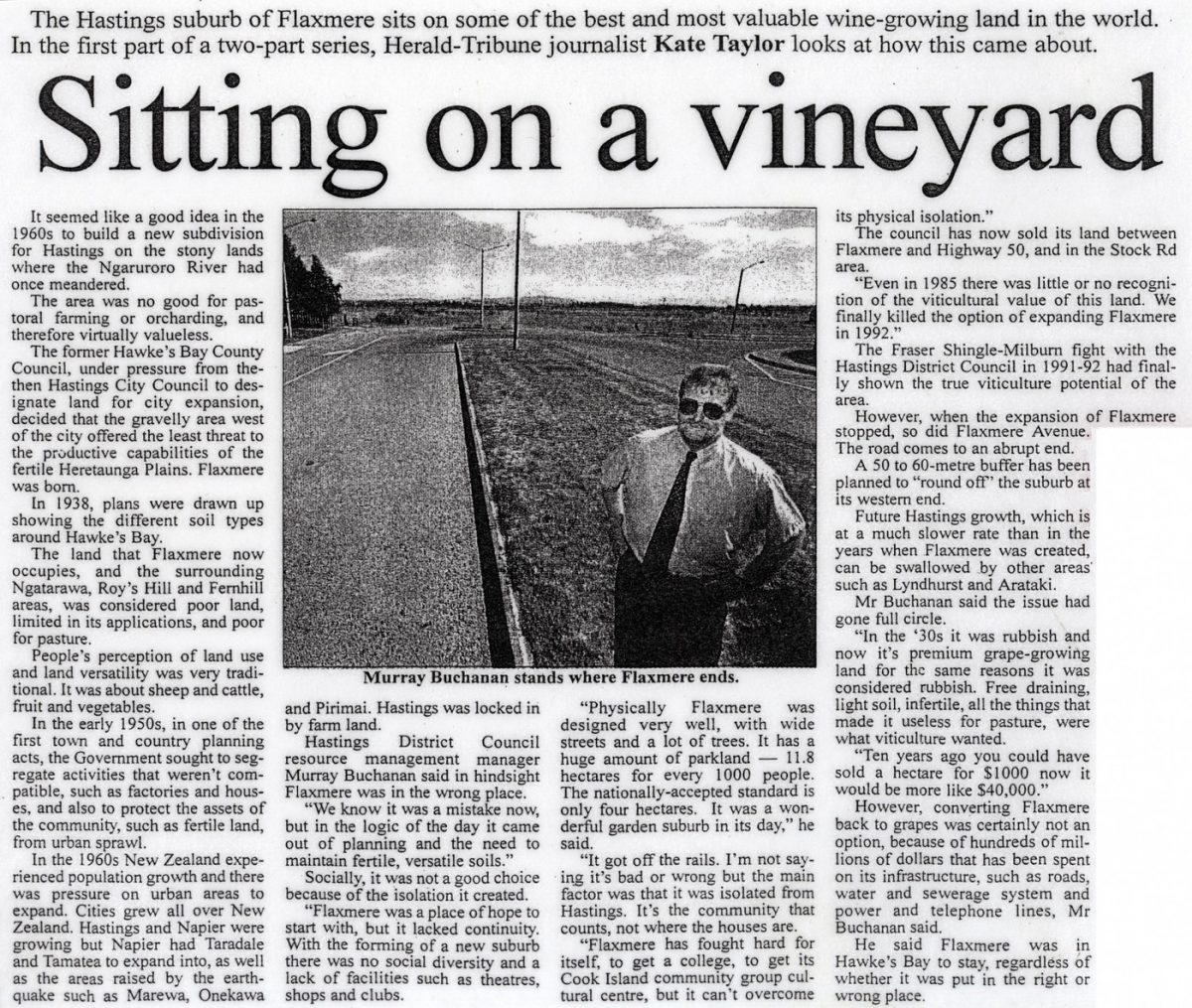The Hastings suburb of Flaxmere sits on some of the best and most valuable wine-growing land in the world. In the first part of a two-part series, Herald-Tribune journalist Kate Taylor looks at how this came about.
Sitting in a vineyard
It seemed like a good idea in the 1960s to build a new subdivision for Hastings on the stony lands where the Ngaruroro River had once meandered.
The area was no good for pastoral farming or orcharding, and therefore virtually valueless.
The former Hawke’s Bay County Council, under pressure from the-then Hastings City Council to designate land for city expansion, decided that the gravelly area west of the city offered the least threat to the productive capabilities of the fertile Heretaunga Plains. Flaxmere was born.
In 1938, plans were drawn up showing the different soil types around Hawke’s Bay.
The land that Flaxmere now occupies, and the surrounding Ngatarawa, Roy’s Hill and Fernhill areas, was considered poor land, limited in its applications, and poor for pasture.
People’s perception of land use and land versatility was very traditional. It was about sheep and cattle, fruit and vegetables.
In the early 1950s, in one of the first town and country planning acts, the Government sought to segregate activities that weren’t compatible, such as factories and houses, and also to protect the assets of the community, such as fertile land, from urban sprawl.
In the 1960s New Zealand experienced population growth and there was pressure on urban areas to expand. Cities grew all over New Zealand. Hastings and Napier were growing but Napier had Taradale and Tamatea to expand into, as well as the areas raised by the earthquake such as Marewa, Onekawa and Pirimai. Hastings was locked in by farm land.
Hastings District Council resource management manager Murray Buchanan said in hindsight Flaxmere was in the wrong place.
“We know it was a mistake now, but in the logic of the day it came out of planning and the need to maintain fertile, versatile soils.”
Socially, it was not a good choice because of the isolation it created.
“Flaxmere was a place of hope to start with, but it lacked continuity. With the forming of a new suburb there was no social diversity and a lack of facilities such as theatres, shops and clubs.
“Physically Flaxmere was designed very well, with wide streets and a lot of trees. It has a huge amount of parkland – 11.8 hectares for every 1000 people. The nationally-accepted standard is only four hectares. It was a wonderful garden suburb in its day,” he said.
“It got off the rails. I’m not saying it’s bad or wrong but the main factor was that it was isolated from Hastings. It’s the community that counts, not where the houses are.
“Flaxmere has fought hard for itself, to get a college, to get its Cook Island community group cultural centre, but it can’t overcome its physical isolation.”
The council has now sold its land between Flaxmere and Highway 50, and in the Stock Rd area.
“Even in 1985 there was little or no recognition of the viticultural value of this land. We finally killed the option of expanding Flaxmere in 1992.”
The Fraser Shingle-Milburn fight with the Hastings District Council in 1991-92 had finally shown the true viticulture potential of the area.
However, when the expansion of Flaxmere stopped, so did Flaxmere Avenue. The road comes to an abrupt end.
A 50 to 60-metre buffer has been planned to “round off’ the suburb at its western end.
Future Hastings growth, which is at a much slower rate than in the years when Flaxmere was created, can be swallowed by other areas such as Lyndhurst and Arataki.
Mr Buchanan said the issue had gone full circle.
“In the ’30s it was rubbish and now it’s premium grape-growing land for the same reasons it was considered rubbish. Free draining, light soil, infertile, all the things that made it useless for pasture, were what viticulture wanted.
“Ten years ago you could have sold a hectare for $1000 now it would be more like $40,000.”
However, converting Flaxmere back to grapes was certainly not an option, because of hundreds of millions of dollars that has been spent on its infrastructure, such as roads, water and sewerage system and power and telephone lines, Mr Buchanan said.
He said Flaxmere was in Hawke’s Bay to stay, regardless of whether it was put in the right or wrong place.
Photo caption – Murray Buchanan stands where Flaxmere ends.












Do you know something about this record?
Please note we cannot verify the accuracy of any information posted by the community.